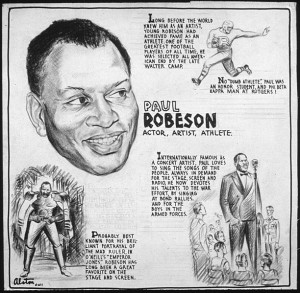By Steve Thornton
It was called the “greatest mobilization of police in the city’s history.” But the event that brought out hundreds of Hartford-area police to Keney Park was not a riot, not a strike—it was the November 15, 1952, concert by Paul Robeson.
The controversial actor and singer had played to 3,000 people in Hartford in 1945 at Bushnell Memorial Hall. This time, however, Robeson ran into stiff opposition as his supporters attempted to secure Weaver High School across from the park (now Martin Luther King Jr. Middle School). The performance was a benefit for the progressive electoral efforts of Connecticut’s Peoples’ Party.
Outspoken Performer Makes Enfield Home
Robeson was no stranger to the Hartford area. In 1940, he and his family bought a home, that became known as “The Beeches,” in Enfield. Robeson’s wife, Eslanda, enrolled in courses at the Hartford Seminary and was a featured speaker at the meetings of local organizations. Robeson’s long history of engaging in fights for racial equality, workers’ rights, and detente with the Soviet Union (decades before it became official US policy) followed him to Connecticut.

Editorial drawing of Paul Robeson by artist, Charles H. Alston, 1943 – National Archives and Records Administration
What infuriated his detractors most was Robeson’s refusal to condemn the Communist Party or to state whether or not he was a member. “Why do you not stay in Russia,” he was asked during a 1956 appearance before the House Committee on Un-American Activities (HUAC). Robeson replied:
Because my father was a slave, and my people died to build this country and I am going to stay right here and have a part of it just like you. And no fascist-minded people will drive me from it. Is that clear?
Performer-Activist Faces Red Scare and Racism
His left-leaning views—and high profile—made him an especially important target for those who had a stake in the status quo. He was hounded by the HUAC, spied on by the FBI, and denied a passport to tour abroad. His life was frequently threatened and his effigy was burned by the Ku Klux Klan. His every move garnered negative headlines at a time when Black people were otherwise largely invisible to the news media. “The persecution of Paul Robeson by the Government…has been one of the most contemptible happenings in modern history,” wrote W. E .B. Du Bois, noted intellectual, author, and civil rights activist.
The Hartford controversy stemmed directly from the August 1949 outdoor performance that Robeson had been scheduled to give in Peekskill, New York. Stirred by inflammatory press reports, the event turned into a wholesale attack on concert goers by hundreds of American Legion-led thugs. Rioters pulled men from their cars and beat them; then they smashed and overturned the cars. The rioting went on for three hours before the state police arrived. No arrests were made. A second Peekskill concert was held two weeks later. Under heavy guard by union members and WWII veterans, Robeson defiantly sang. Leaving the concert, however, meant attendees had to run a gauntlet of bottles and stones from thousands of protestors who included, according to eyewitnesses, the police themselves. More than 85 scheduled Robeson concerts around the country were cancelled in the next year due to political pressure.
In Hartford, conservative veterans’ groups lined up to oppose the Robeson concert. City Council member John J. Mahon led the political effort to stop Robeson. Even the local teachers’ union petitioned the Council and the Board of Education to rescind the Weaver High permit.
Supporting Robeson’s right to appear was the local chapter of the American Jewish Congress. Also backing his right to sing was city councilwoman Betty Knox and Board of Education president Lewis Fox.
The Hartford newspapers played a significant role in red-baiting Robeson and playing up the fears of violence. Early in the controversy, the Hartford Times ran a front-page article entitled “Robeson Among Guests at Red Embassy.” Letters to the papers warned Hartford people not to be “liberal with our freedom of speech when it comes to Communism.” When provocative questions from a local reporter angered Robeson, that, too, became a story. “Robeson Enraged as Party Membership is Questioned,” read the Hartford Times headline. Robeson’s anger was eloquent and pointed. “The white ruling class of America doesn’t like Negroes who stand up and talk back and fight for their rights,” he told the reporter.
In the end, Robeson did sing at Weaver High School, to an auditorium packed with 800 people. The audience called him back for six encores.
Steve Thornton has been a labor union organizer for 35 years and writes on the history of working people.
This article originally appeared on ShoeLeatherHistoryProject.com









